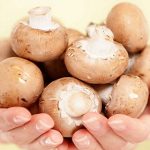by Ocean Robbins: Do you know how to store produce properly? Or does it often go to waste?
Imagine that you received your salary in cash, and every other Friday, you take home a stack of bills. You’d spend some of it on necessities and perhaps an indulgence or two. You’d save some — if there were any left. Here’s what you probably wouldn’t do: put a bunch of twenties and fifties into a drawer; then take them out and shred them a week later.
But that’s precisely what we do when we buy fresh produce and don’t eat it. With the best of intentions, we gather gorgeous greens and radiant reds and yummy yellows from produce sections and farmers markets. We bring them home, stick them in the refrigerator, or leave them out on the counter, only to toss them in a few days because they’ve wilted or become moldy or started to smell.
It’s easy to beat ourselves up for this irresponsible pattern, but I have a better idea. Let’s discover the science and practice how to store produce, so it lasts longer, tastes better, and retains as much nutritional goodness as possible. Armed with this information, we can turn our kitchens from veggie graveyards into zero-waste nutritional powerhouses.
How Soon to Use Produce
Let’s start our exploration of how to store produce with a look at how long produce lasts. That way, when you’re shopping, you’ll have an idea of whether to buy that 10-pound bag of sweet potatoes or if they’ll spoil before you have a chance to prepare and eat them.
Because there are hundreds of different kinds of fruits and veggies, I won’t go into the details of each type. (To give you an idea of how long this article would be: in my research, I discovered that different varieties of apples behave differently when stored in identical ways. And there are more than 7,500 varieties of apples in the world!) Instead, I’ll share three easy-to-remember categories, give you a few examples from each category, and provide links to the “motherlode” databases where you can look up your own favorite fruits and veggies at your convenience.
The ASAP Produce (2-5 Days)
Some fruits and vegetables want to be eaten right away. It’s like they start diminishing while they’re still in your shopping cart. Don’t run red lights and stop signs to get them home, but do have a plan for when and how you’re going to serve them in the next two to five days.
ASAP fruits include apricots, berries, mangoes, peaches, plums, and ripe bananas. Veggies with a ticking clock include what I’ll call cooking greens (bok choy, chard, kale, and spinach), and common salad ingredients such as cucumbers and tomatoes. Fresh herbs typically also go in this category: basil, chives, and other leafy condiments.
The Soon-ish Produce (5-7 Days)
Other fruits and veggies will give you a slightly longer consumption window. Fruits in this category include cherries, oranges, grapes, and pears. Lots of vegetables fit this bill, from nightshades like bell peppers and eggplant to the “head-shaped” cruciferous crowd of broccoli, Brussels sprouts, cabbage, and cauliflower. Other common veggies in this category include green beans, sweet corn, lettuce, mushrooms (technically not a veggie, I know, but neither are peppers or tomatoes. We’re giving ourselves some linguistic slack), summer squash, and baby potatoes.
The No Hurry Produce (1-2+ Weeks)
Some fruits and veggies are patient and will wait weeks and sometimes even months for you to get around to eating them. Apples, lemons, and limes are the endurance athletes of the fruit kingdom. At the same time, root vegetables like beets, carrots, ginger, onions, large potatoes, sweet potatoes, and turnips win the vegetable ultramarathon, along with the longevity superstars — winter squashes like butternut.
These categories serve as guidelines on how to store produce, not hard and fast rules. Sometimes the broccoli is already turning yellow, the bananas resemble giraffes, and the pears are soft as marshmallows. And avocados and kiwis can be rock hard and need a week or more to ripen. Or they can be so mushy that they need to be eaten more-or-less immediately. In each case, use your own best judgment, based on the condition of the produce when you buy it.
How to Store Produce
In addition to the state of the produce when you get it, the amount of time you have it can also impact how to store produce. Light, temperature, humidity, and even proximity to other fruits and vegetables can speed up or slow down the ripening and rotting process.
Some fruits and veggies need to be refrigerated right away to keep them from losing nutritional value or spoiling. In fact, that applies to most of them. It’s easier to list the exceptions.
Countertop Fruits and Veggies
Fruits that should go on the countertop include citrus, bananas, melons, and pineapple as long as they’re whole and uncut. Vegetables that ideally shouldn’t see the inside of your fridge in their intact state include garlic, onions, winter squash (the moisture in the fridge can make them rot faster), and potatoes (refrigerating potatoes could increase their sugar content, leading to higher acrylamide levels when cooked).
I assume that my refrigerator is dark when the door is closed (I suppose I could install a surveillance camera to verify, but I’m pretty sure). Some of the countertop produce doesn’t mind light, but others interpret light as a signal to start growing roots and shoots. Onions and potatoes need darkness to keep them dormant and fit for our consumption. Also, they need to be kept separate, as the chemicals released by onions can get potatoes to start sprouting. (Which makes me wonder, what else are these veggies saying to each other behind my back!)
What to do with Fresh Herbs and Spices
Fresh basil is best picked straight from the garden and used within hours, but if you can’t grow your own or have access to a farmer’s market, you can make basil last by trimming the stems and sticking them in a mason jar filled with two inches of water. And keep them out of sunlight.
Ginger can sit on the counter as-is but will last longer if you store it in an airtight ziplock bag. One fun ginger hack is to peel the roots with the back of a spoon, cut them into half-inch chunks, and freeze them in a freezer bag. That way, you always have ready-to-use ginger for soups and stews and stir-fries; being frozen, they grate much more easily than fresh ginger root, and they retain their strong flavor.
The Ever Elusive Avocado
Avocados are the most delicate and demanding fruit when it comes to overripening. Sometimes, it seems like they go from underripe to spoiled in less time than the average sneeze. One way to prolong the life of an avocado — and other stone fruit, like peaches and plums — is to allow it to ripen on the counter. Then, put it in the fridge just before it reaches full ripeness. The cool and dark will slow its descent from edible to compostable. And then, you can get it out in time for it to warm up and complete its final bit of ripening a few hours before you plan to eat it.
For a comprehensive list of fruits and vegetables, and how to store produce, check out this databasefrom FruitsandVeggies.org. If you want a 10-page, printable PDF to decorate your refrigerator door, the fine folks at Half Your Plate have you covered.
Speeding Up Ripening
Have you ever found yourself begging a stone-hard avocado on your counter to please ripen so you can make that taco bar for dinner — or done a “turn yellow” dance to get a few bananas primed for a smoothie?
If so, you’ll know that sometimes we want to speed up ripening, rather than delay spoilage, in fruit. In addition to avocados and bananas, sometimes you want to enjoy tree fruit — pears, plums, peaches, persimmons, and some other fruits that don’t start with the letter “P” — a bit sooner too.
The best way to ripen fruit is on the counter, at room temperature, and inside a paper bag. Keep the bag out of direct sunlight, so you don’t accidentally turn it into a brown greenhouse and stew your fruit. Don’t use sealed plastic bags either; the poor fruit needs to breathe. If your indoor humidity is low, the fruit can lose moisture. You can reduce this effect by placing it in a vented bowl or metal colander.
Check on it daily, since different fruits ripen at different rates. In general, your fruit is ripe when the flesh gives a little to your touch. If it’s turned into a mushy puddle infested with fruit flies, you can be pretty sure it’s overripe and no good anymore.
If you want to speed up the ripening even more, add a ripe apple (except for Granny Smith or Fuji, which don’t release enough ethylene to make a meaningful difference) or banana to the paper bag with your fruit of choice, as they give off a chemical called ethylene, which triggers ripening.
How to Store Produce in the Refrigerator: Temperature, Humidity, and Placement
Don’t just throw all the fridge-friendly produce straight into your refrigerator; take a few extra minutes to do it right for optimal freshness and minimal yuckiness.
When figuring out how to store produce, the temperature of your fridge should be, well, cold. No higher than 40 degrees Fahrenheit, according to the USDA. And there’s evidence that lower — closer to 35-38 degrees — is better.
Most refrigerators don’t give you control over the humidity of the chamber. And since the main compartment cools from air blown in from the freezer, the humidity can be quite low. In fact, the only sources of refrigerator humidity are the outside air from when you open the door and look for something, and the ripening produce itself.
You can slow the evaporation from your refrigerated fruits and vegetables by placing them in the crisper drawers, which are typically humidity-controlled. Or store produce in plastic bags with holes punched in them (the University of California at Davis has done the math: 20 pin-sized holes in a medium bag should do the trick) or in reusable produce bags like these.
Separate your fruits and veggies to protect the latter from the fruits’ ethylene peer pressure (or is it “peel pressure”?). You can place them in separate compartments, as most modern fridges have dual fruit and vegetable crisper drawers.
Still, the number one strategy for dealing with refrigerated produce is: eat it sooner rather than later.
Using Your Freezer
If your produce’s biological clock is ticking, and you can’t consume it all before nature’s expiration date, your freezer can (almost) stop that clock for certain fruits and vegetables.
A good guiding framework is, if you can buy it in a market freezer case, you can probably freeze it yourself. But there are a few things to keep in mind to get satisfactory (and safe) results. First, some vegetables need blanching before freezing. No, this has nothing to do with the Golden Girls. You blanch veggies by cutting and then exposing them to boiling water or steam for a short period of time before dunking them in ice water. How long depends on the vegetable and the size of the chunks. You’re aiming to kill any surface bacteria and deactivate the enzymes that trigger ripening and spoilage without cooking the vegetable. The ice water bath at the end stops the cooking process.
Second, make sure your freezer environment can handle frozen produce. Keep the temperature below 32 degrees Fahrenheit (0 Celsius). Put all produce into airtight, freezer-safe containers, or silicone bags (like these).
Third, freezing time matters, as well. Don’t overwhelm your freezer with so much room-temperature produce that it takes more than two hours for everything to freeze solid. This comes out to about 2-3 pounds of produce per cubic foot of freezer space for every 24 hour period.
Don’t freeze produce that contains so much water that the cell walls all rupture as that water expands into ice. Lettuce is a really good example of what not to stick in your freezer, as the leaves will quickly turn to mush once they defrost. Other freezer no-nos include raw tomatoes, cucumbers, and bell peppers. High starch vegetables like corn, lima beans, and peas, in contrast, freeze very well.
Fruits that freeze well include berries, cherries (I recommend pitting them first unless you want a very tedious job or very broken tooth later), peaches, and tropical fruits such as mango, pineapple, and papaya.
The nice thing about freezing fruits and vegetables is that it’s a great way to maintain their nutritional value, compared to letting them age on the counter or refrigerator or preserving them by canning or dehydrating them.
What About Storing Cut Produce?
As the food revolution continues to spread, retailers are stocking more and more pre-cut fruits and vegetables as a nod to changing tastes. People will often choose healthy options if they’re as convenient as unhealthy ones. So now you can find bags of pre-cut broccoli, cauliflower, baby carrots (which are not babies at all, but larger carrots carved into bite-sized chunks) for snacking, as well as pre-cut and spiralized squash, sweet potatoes, roots for tossing into a soup or stew. “Zoodles,” or noodles made out of spiralized zucchini, are becoming popular among pasta lovers who are watching their weight, are gluten-free, or just want to add more plant-based yumminess to their lives.
And we’ve always had cut fruit platters and cups to grab and go, or to pick up on the way to a potluck or soccer game.
But sometimes, we want to cut our own produce, whether to make carrot and celery sticks that we’ll enjoy with a dip throughout the day or to get that giant papaya off the counter and into a lunchbox for tomorrow’s dessert. One trick here is to use a very sharp knife; dull knives can damage produce, speeding up the leakage of valuable minerals, and producing off-odors. (Just make sure to spare your fingers.) And of course, always use a clean knife, so you don’t introduce molds, unwanted flavors (like garlic or onion!), and other contaminants.
The important thing to remember about produce is that cutting them turbocharges their biological clock. They’re losing nutrients from every surface and will go bad sooner than if they were intact. If you can’t eat them right away, then store them in airtight containers in your refrigerator. But seriously, try to eat them right away if you can.
Sad Greens
What about leafy greens that have wilted? Do you have to toss or compost them, or can they be saved?
Because leafy greens contain so much surface area, it’s possible for them to wilt (i.e., dehydrate) without losing most of their nutritional value. You can revive greens, sometimes, by cutting their stems and placing them in a jar of water. Stand them upright, like a vase of flowers. Maybe tell your partner you got them a bunch of kale as a romantic gesture (Hey, it just might work!). And a good destination of last resort for wilted veggies can be a big pot of soup or stew as well.
When to Wash Your Produce
Most produce should not be washed before storage. The water and handling can erode the plant’s natural protective coating, making it more susceptible to damage and degradation on your counter or in your fridge. Instead, store most produce unwashed, and wait until you’re ready to prepare or eat it. If you like to leave fruit on the counter for “grab-and-go” purposes, you can wash apples, peaches, plums, and other fruits and then dry them with a towel. For the in’s and out’s of how to wash produce to remove dirt and pesticide residue, we’ve got a whole article on just that topic.
The exception to the wait-to-wash rule is the leafy salad greens like spinach and different varieties of lettuce. They will keep better and longer if you wash them first. Then dry them completely before storing, either in a salad spinner or wrapped in cotton kitchen towels inside a sealed plastic bag.
Avoid the Moldy Oldies
Of course, we want our produce to be fresh, delicious, and nutritious. But even more important than all those positives is avoiding the big negative of poor food storage: mold. Molds are tiny fungi, but not the kind you want on your pizza. Many can make you ill, and some have been found to be extremely carcinogenic, like aflatoxin, which can form on peanuts and corn.
The basics of mold avoidance are simple. First, don’t buy moldy produce. Look especially closely at bagged fruit and onions, as a few nice specimens on the outside might be obscuring a green fuzzy disaster in the center. Once you’re the proud owner of the produce, cut off all moldy spots, and get them contained and out of the house. (Ideally, add them to a compost pile!). Don’t sniff moldy spots, however; those spores do not belong in your nose! And clean your refrigerator every few months with a mixture of one tablespoon baking soda per quart of water.
For the full scoop, here’s a link to the USDA’s comprehensive look at how to spot and prevent mold.
Get the Most from Your Produce
Remember, a lot of energy and effort (and perhaps love) went into the fruits and vegetables that find their way to your home. The best way to show your appreciation for all this goodness is to steward them well into your family’s bellies, with as little loss of flavor, texture, and nutrients as possible.









































